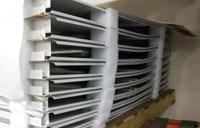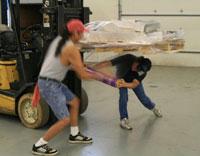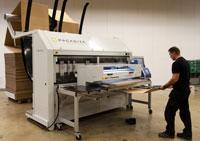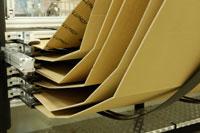Senior Editor
- FMA
- The Fabricator
- FABTECH
- Canadian Metalworking
Categories
- Additive Manufacturing
- Aluminum Welding
- Arc Welding
- Assembly and Joining
- Automation and Robotics
- Bending and Forming
- Consumables
- Cutting and Weld Prep
- Electric Vehicles
- En Español
- Finishing
- Hydroforming
- Laser Cutting
- Laser Welding
- Machining
- Manufacturing Software
- Materials Handling
- Metals/Materials
- Oxyfuel Cutting
- Plasma Cutting
- Power Tools
- Punching and Other Holemaking
- Roll Forming
- Safety
- Sawing
- Shearing
- Shop Management
- Testing and Measuring
- Tube and Pipe Fabrication
- Tube and Pipe Production
- Waterjet Cutting
Industry Directory
Webcasts
Podcasts
FAB 40
Advertise
Subscribe
Account Login
Search
How to wrap up packaging problems
Fabricators streamline historically laborious packing operations
- By Tim Heston
- August 3, 2012
- Article
- Assembly and Joining

Figure 1: Foam and inserts separate and protect these panels for shipment at EVS Metal. Good packaging not only considers potential points for damage, but also weight, including how the weight of stacked parts affects parts on the bottom. Photo courtesy of EVS Metal.
A shipment arrived at your customer’s facility, and the customer calls to complain. The parts apparently are dented, scratched, or otherwise unusable. How did it happen? Did someone at the customer’s loading dock rub the sheet metal panels together as he was lifting them out of the box? Did the boxes fall as the truck driver made a hard stop in transit? Did people in your own assembly or shipping department pack the boxes or pallets incorrectly? Was a pallet’s center of gravity off-kilter?
When you get right down to it, customers want good products delivered on time, every time, and this requires good packaging. Say a shop offers an innovative delivery: kitted parts packed so workers at the customer plant can lift them out in a certain order that will make their assembly process easier. Like good sheet metal design, packaging can directly affect a customer’s manufacturing efficiency.
Assembly and packaging represent the final operation at most contract metal fabricators. Bottlenecks in packaging trickle upstream. A shop may have amazing lights-out automation, lightning-fast sheet metal cutting, advanced precision bending, and even automated welding. No matter how quickly fabrication occurs, though, products won’t ship any faster unless packaging can keep up.
In one sense, a poorly packaged pallet of parts damaged in transit turns all that value-adding upstream activity—cutting, deburring, bending, welding, grinding, heat treating, plating, powder coating, hardware insertion, and assembly—into waste. All those processes just produced a batch of parts that couldn’t be sold.
Quality packaging ensures parts arrive at a customer site unscathed. Efficiency ensures packaging doesn’t hinder part flow, both at the contract fabricator and its customer. Like at the track-and-field relays at the summer Olympics, the race can be won or lost with the handoff.
Customer Collaboration
The longer the truck ride, the more risk there is that a pallet or box of parts could be damaged. Quick and reliable response, after all, is one of the key selling points for domestic manufacturing.
A fabricator’s locale can be a competitive advantage, and it’s also why some fabricators are opening satellite locations. For instance, EVS Metal of Riverdale, N.J., has opened locations in Strasburg, Pa., and elsewhere, simply to be close to customers. No matter how well a product is packaged and securely loaded onto a truck, a long truck ride still increases risk of part lateness or damage. Proximity mitigates that risk.
But it doesn’t eliminate it entirely. Bad packaging can damage parts, no matter how short the truck route is. As EVS Vice President Joe Amico described, good packaging ensures certain part elements don’t touch each other and scratch, a problem avoided by using foam, blocks of wood, or other items to separate parts (see Figure 1)—a particular challenge when assemblies have inserted hardware.
A good packaging strategy also considers weight. “Even simple flat panels can be difficult to package,” said Amico. Such a panel may be a relative snap to fabricate: laser-cut, then form two short return flanges, and that’s it. But stack those thin-gauge parts too high, and the weight of the top panels may bend panel flanges on the bottom. Even a slight bend may wreak havoc at a customer’s assembly plant.
Fabricators have rethought the very notion of a packaging department. Instead, inline packaging—basically a “pack as you go” concept—has helped some fabricators relieve bottlenecks. If parts are ready to be packed, there’s really no reason to wait. If finished parts are handled extensively before being packaged, they have a greater chance of becoming scratched or damaged. The sooner a certain piece part can be placed in a protective package, the better. The operators may collect parts after a powder coating operation or immediately after assembly and then pack them before taking them to a finished-goods warehouse or the shipping department.

Figure 2: Before Micron Metalworks invested in automated shrink-wrapping equipment, workers manually wrapped part skids. Now Micron’s stretch-wrapping operation is entirely automated, faster, and safer. Photo courtesy of Micron Metalworks.
Such practices don’t make sense for every situation, of course. Requiring a skilled (and well-paid) welder working at a constraint operation to spend half his day packing may not be practical. But at nonbottleneck work centers, packaging could be seen very much as a value-adding activity. After all, a part doesn’t make money until it leaves the loading dock, and it can’t leave without being packed. And as sources explained, the last thing an operator wants is his handiwork ruined by careless packaging.
Such packaging strategy also must factor in how the customer will unpack and use the kit or batch of parts. What if a worker scraped the part because he or she had to disassemble or manipulate a box in an awkward way? What if sharp ends of box staples dug into the sheet as the person was opening the package? Seemingly low-tech problems can effectively ruin an expensive part produced with the latest manufacturing technology.
“There is a certain amount of cost that’s added into pricing to cover packaging,” Amico said. “And when you look at it in relation to overall costs, it’s more expensive than you might think.”
It can get really expensive if parts are damaged in transit. In these instances, controlling the shipping operation helps. Since EVS was launched in 1994, the fabricator has maintained its own trucking fleet (though the company does use common carriers for certain orders). According to Amico, the benefits of controlling the shipping operation have outweighed the costs. Not only does a fabricator-owned truck fleet give a contract manufacturer more control over transportation and logistics, it also means that the employee driving and unloading the truck witnesses a customer’s operations frequently.
The delivery team can become an important communication link between the fabricator and its customer. After multiple deliveries, the truck driver can start to learn how parts are unloaded and, sometimes, even unpacked and assembled. “These people get feedback, and they take that back to our factory and help us improve,” Amico said.
This intelligence spurs dialogue: Should parts be packaged or stacked differently? Are reusable boxes or containers an option? Are batches, kits, or subassemblies being delivered at the right time? The more frequently a driver visits the customer, the more insight a fabricator can gain. In fact, repeat orders are areas ripe for packaging improvements. Customers may be willing to invest in returnable boxes or containers, if it will make life easier for their end of production.
Automated Stretch Wrapping
Stretch wrapping has become pervasive in an industry that ships an incredible variety of parts, from batches or kits of parts that can be easily boxed to massive subassemblies that aren’t practical for boxing. Stretch wrapping can’t change the laws of gravity; a poorly loaded part still can tip in transit. Regardless, sources said that for the right application, stretch wrapping can hold some loads more securely than older methods.
Stretch wrapping can, however, be an ergonomic nightmare, if not outright unsafe. As workers apply stretch wrapping manually, they sometimes stick their head underneath a pallet lifted by a fork truck. Greg Engen pointed to a photo depicting just such a situation (see Figure 2). The plant manager at Micron Metalworks in Ham Lake, Minn., northwest of Minneapolis, showed how two workers wrapped a small batch of parts.
To remedy the unsafe practice, Micron invested in an automated stretch-wrapping machine from Louisville, Ky.-based Lantech. A fork truck driver places a pallet of parts on the system, which then wraps the pallet horizontally, unitizing the load. “We just set the pallet on there, hit the button, and walk away, and it wraps it for us,” he said. This, he added, freed a packaging bottleneck.
Such automation not only has transformed shipping departments, but also the logistics industry overall, as Paul Stewart, director of marketing at Lantech, explained. “Forty years ago, most trucks used to be floor-loaded,” as workers with hand trucks manually loaded box after box. Today, with loads unitized and stretch-wrapped on a 40- by 48-inch pallet (an industry standard), a fork truck driver loads a trailer in minutes.

Figure 3: Automated shrink-wrapping systems like this automate a traditionally laborious process. Photo courtesy of Yellow Jacket/ITW-GaleWrap.
Today stretch wrapping not only unitizes loads, but also helps secure loads to pallets. As Stewart explained, some stretch-wrap machines can make so-called “film cables,” which are stretch film rolled up to form a cable that can secure a load to the sides of a pallet, while allowing space for a fork truck to lift the load.
Other machines apply stretch wrap vertically, over the parts and under the pallet. A part or pallet of parts is lifted on a fork truck and is driven into the wrapping machine (see Figure 3). As Mike Stell, product manager for Douglasville, Ga.-based Yellow Jacket/ITW-GaleWrap, explained, fabricators automate shrink wrapping for three
principal reasons. “One is the speed—the time it takes to package a shipment. Two is how well the load stays on the pallet itself. And three is employee safety.”
No longer must employees break their backs or move their heads or hands near potential hazards—like under the forks of a truck—to manually wrap a batch of parts. The automated process also allows companies to ensure tight wrapping of parts and avoid less optimal packaging methods.
Certain stretch wrap is made of tough lattice material that doesn’t tear linearly (or “zipper”) when wrapped tightly over a sharp edge, Stell said. This means that a part that previously would have needed to be screwed down to a pallet or held in place with metal straps can now be stretch-wrapped with an automated system.
Stewart added that which wrapping material a shop chooses boils down to cost and reliability. Wrapping machine operators must find the optimal containment force for the load. Wrap too tightly, and the stretch film is more likely to tear. To compensate, the operator wraps less tightly but perhaps applies more film (more revolutions of the machine) to compensate for the reduced containment force.
Thinking Inside the Box
In the packaging arena, there’s one overarching problem: the ever-shortening product life cycle. Why invest in returnable containers or other custom-built packaging if the product will become obsolete in a few months?
This is an obvious problem for discrete products—those ordered only on occasion, and often only once. Returnable racking or custom boxes just won’t work. In fact, such low-volume work continues to make up a greater portion of U.S. manufacturing overall. Shops must inventory standard box sizes, which means packers often are stuffing relatively small parts in boxes that are too big, hence the need for inserts and filler.
“It’s important for manufacturers in the U.S. to excel at custom, one-off, just-in-time delivery,” said Brandon Bingham, vice president of global operations at Salt Lake City, Utah-based Packsize International. “But this creates a huge inventory of boxes [at the fabricator], or sometimes the inability to have the right box when it’s needed.”
He added that this creates a ripple effect upstream and downstream from packaging. Say a job is almost ready, but assemblers packaging parts discover they’re short two boxes. At best, they may choose larger boxes but use excess filler. This means fewer parts fit on a truck, and the chances of parts being damaged in transit or at the customer’s facility become greater. At worst, a fabricator may be forced to move the job off to the side, left to sit in the shipping area, taking up space and delaying the customer shipment. This in turn may trigger a change in the production schedule upstream or the shipping schedule downstream. “All this creates more and more inefficiencies and waste,” Bingham said.

Figure 4: This machine can make boxes and inserts on demand using a stock of corrugated cardboard. Photo courtesy of Packsize International.
Some companies, though, actually have been fabricating boxes on-site. For instance, InterMetro Industries, an Emerson subsidiary that fabricates and assembles custom metal shelving, uses a machine that can make a box on demand. Its sheet metal shelving assembly plant in Wilkes-Barre, Pa., doesn’t stock umpteen standard-sized boxes, ordered in bulk thanks to traditional economic-order-quantity pricing.
Instead, the company stocks a set amount of corrugated Z-fold cardboard (see Figures 4 and 5). As its name implies, the material looks like a Z as it unfolds and feeds into the system. That material is fed into a box-making machine, which creates a custom box. The stronger the exterior or the thicker the interior padding required, the more layers of corrugated cardboard the machine cuts and folds. (Packsize leases equipment to customers, but makes much of its revenue on the consumables it sells—that is, the Z-fold stock.)
Once InterMetro determines the part shape and size (in this case, custom metal shelves), an operator uses a unique CAD program to design a box to fit around the contents to be shipped, be it one part, a batch, or a kit of dissimilar components. The box design can be programmed at the machine or downloaded to the controller. The design leaves a bit of space between the box interior and the part exterior, but not too much. The part should be snug enough to withstand jostles during shipment, but loose enough for the customer to unpack parts easily. This eliminates excessive packing material, so more parts can be shipped in less space on a truck, and ship less “air”—that is, peanuts, foam, and other filler used when boxes are too big.
Boxes are made on demand and staged where needed. For instance, a worker might retrieve a batch of 20 cooled powder-coated shelves and pack them in 20 boxes, which are staged and at the ready. This in turn may trigger a subsequent lot of, say, five boxes to be made, which can be fabricated just-in-time and be staged for the next batch, which quite often is a completely different order.
Because custom boxes have little excess space for peanuts or other filler, more products can fit in less space on a truck. Moreover, customers or distributors may request that a certain product be packaged, say, three components to a box instead of four—and InterMetro can accommodate. The company also avoids hand stacking into the truck trailer, designing all packaging so it can fit on a pallet and be transported in and out on a fork truck.
As John Skuchas, director of operations at InterMetro Industries, explained, “We don’t do physical [box] inventories, because we don’t have a problem with our carton inventory. It’s now six SKUs [of Z-fold stock]; it’s not 500 SKUs [of different boxes].”
Packing for the Unknown
Fundamentally, good packaging deals well with the unexpected or uncontrollable: a tractor trailer making a hard stop and jostling the pallets or boxes in back; or running out of packaging material just before the end of a hot order. The uncertainties are everywhere.
The trick, sources said, is managing the risk. Fabricators are doing this with plants close to customers, new packaging technology, and, perhaps most important, good customer communication. As with so much in high-mix manufacturing, getting good information about a part—and how it is unpacked, handled, and assembled—wins half the battle.
About the Author

Tim Heston
2135 Point Blvd
Elgin, IL 60123
815-381-1314
Tim Heston, The Fabricator's senior editor, has covered the metal fabrication industry since 1998, starting his career at the American Welding Society's Welding Journal. Since then he has covered the full range of metal fabrication processes, from stamping, bending, and cutting to grinding and polishing. He joined The Fabricator's staff in October 2007.
Related Companies
subscribe now

The Fabricator is North America's leading magazine for the metal forming and fabricating industry. The magazine delivers the news, technical articles, and case histories that enable fabricators to do their jobs more efficiently. The Fabricator has served the industry since 1970.
start your free subscription- Stay connected from anywhere

Easily access valuable industry resources now with full access to the digital edition of The Fabricator.

Easily access valuable industry resources now with full access to the digital edition of The Welder.

Easily access valuable industry resources now with full access to the digital edition of The Tube and Pipe Journal.
- Podcasting
- Podcast:
- The Fabricator Podcast
- Published:
- 04/16/2024
- Running Time:
- 63:29
In this episode of The Fabricator Podcast, Caleb Chamberlain, co-founder and CEO of OSH Cut, discusses his company’s...
- Industry Events
16th Annual Safety Conference
- April 30 - May 1, 2024
- Elgin,
Pipe and Tube Conference
- May 21 - 22, 2024
- Omaha, NE
World-Class Roll Forming Workshop
- June 5 - 6, 2024
- Louisville, KY
Advanced Laser Application Workshop
- June 25 - 27, 2024
- Novi, MI
































